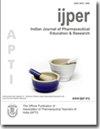Withaferin-A纳米颗粒对阿尔茨海默病大鼠东莨菪碱模型的神经保护作用
IF 0.8
4区 医学
Q3 EDUCATION, SCIENTIFIC DISCIPLINES
Indian Journal of Pharmaceutical Education and Research
Pub Date : 2023-08-23
DOI:10.5530/ijper.57.3s.70
引用次数: 0
摘要
背景:阿尔茨海默病(AD)在65岁或以上的患者中更常患痴呆症。AD的症状与致病神经元有关,目前的药物治疗不能充分调节致命的结果。紫薇(L)是一种传统的多功能草本植物,具有多种健康益处。材料和方法:本研究考察了威沙费林A纳米颗粒对东莨菪碱诱导的神经元损失(对记忆的影响)的重要性。将体重150~200g的6只大鼠随机分成5组。阴性对照组和阳性对照组动物分别接受2mL/kg生理盐水。第3组和第4组分别给药5mg/kg纯威沙弗林-A和威沙弗林-A纳米制剂。第5组接受10mg/kg的他克林作为正常药物。除第1组外,其余各组均于给药后30min用1mg/kg东莨菪碱诱导。EPM用于理解行为参数。结果:威沙弗林-A纳米颗粒和常规药物治疗组的炎症发生率分别为1.1和1.3。同时测定AchE、MDA、GSH还原酶。与纯药物相比,Withaferin-A纳米颗粒表现出显著的活性。Withaferin-A在特定水平上表现出类似于他克林的抗遗忘作用。结论:Withaferin-A纳米粒子对神经退行性疾病有一定的治疗作用。为了将该制剂确定为AD的标准治疗方法,应探讨药代动力学方面的问题。本文章由计算机程序翻译,如有差异,请以英文原文为准。
Neuroprotective Effects of Withaferin-A Nanoparticles on Scopolamine Rat Model of Alzheimer’s Disease
Background: Alzheimer's Disease (AD) suffers from dementia more often in 65-year or older patients. Symptoms of AD's are linked to disease-causing neurons, and current pharmacological therapies inadequately regulate deadly outcomes. Withania somnifera (L ) , has been contributing as a traditional multifunctional herb with a wide variety of health benefits. Materials and Methods: This research examined the importance of Withaferin A nanoparticles against scopolamine induced neuron loss (Impair on memory). Five groups of 6 rats weighing 150-200 g were randomly split. Negative and positive control animals received 2mL/kg saline solution in groups 1 and 2. 3 rd and 4 th group received 5mg/kg of pure Withaferin-A and Withaferin-A nanoformulation. Group 5 received 10 mg/kg of tacrine as a normal medication. Except for group 1, all other groups were induced 30 min after drug administration with 1mg/kg scopolamine. EPM was used to understand the behavioral parameters. Results: Inflexion ratios of 1.1 and 1.3 were seen in groups treated with Withaferin-A nanoparticles and the conventional medication. AchE, MDA, GSH reductase were also measured. Compared to the pure drug, Withaferin-A nanoparticles exhibited substantial activity. Withaferin-A exhibits an anti-amnesic effect similar to tacrine at a specific level. Conclusion: Withaferin-A nanoparticles may help neurodegenerative disease. To establish the formulation as a standard AD's treatment, pharmacokinetic aspects should be explored.
求助全文
通过发布文献求助,成功后即可免费获取论文全文。
去求助
来源期刊
CiteScore
1.40
自引率
0.00%
发文量
227
审稿时长
>12 weeks
期刊介绍:
The official journal of Association of Pharmaceutical Teachers of India (APTI) and is being published since 1967. IJPER, a quarterly publication devoted to publish reviews and research articles in pharmacy and the related disciplines of Pharmaceutical education. It mainly covers the articles of special interest, covering the areas of Pharmaceutical research, teaching and learning, laboratory innovations, education technology, curriculum design, examination reforms, training and other related issues. It encourages debates and discussions on the issues of vital importance to Pharmaceutical education and research. The goal of the journal is to provide the quality publications and publish most important research and review articles in the field of drug development and pharmaceutical education. It is circulated and referred by more than 6000 teachers, 40,000 students and over 1000 professionals working in Pharmaceutical industries, Regulatory departments, hospitals etc.

 求助内容:
求助内容: 应助结果提醒方式:
应助结果提醒方式:


